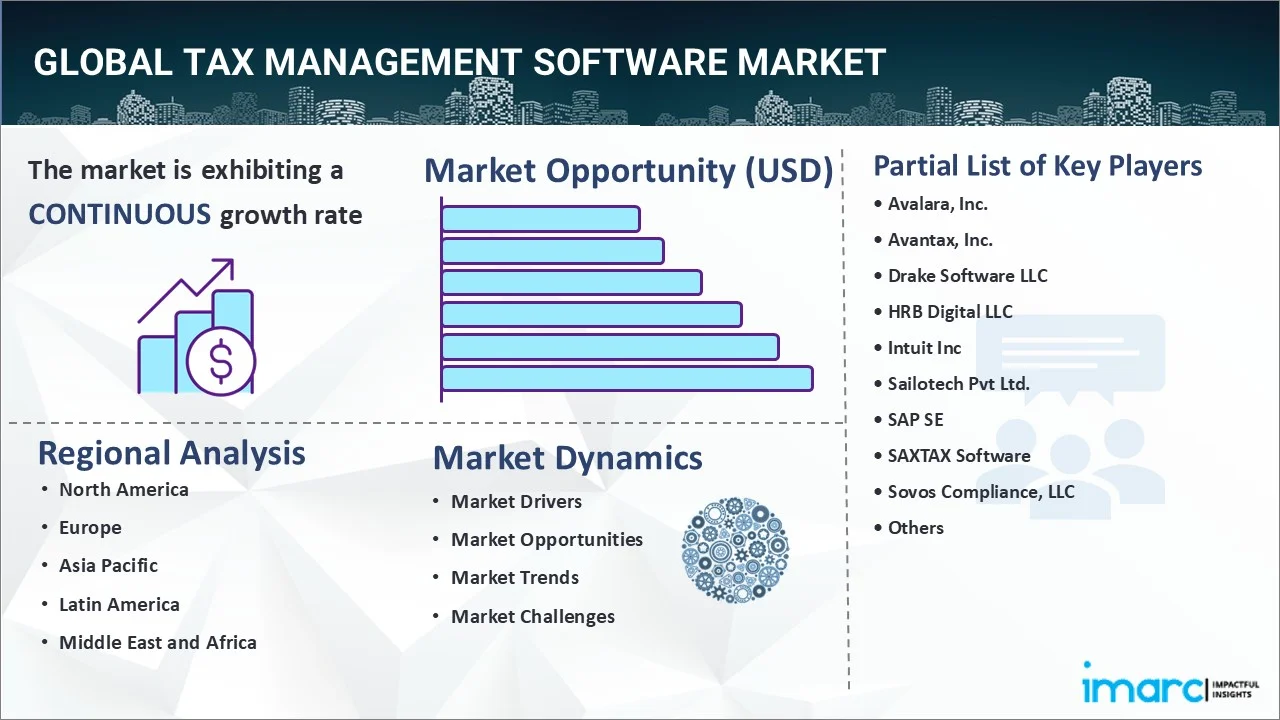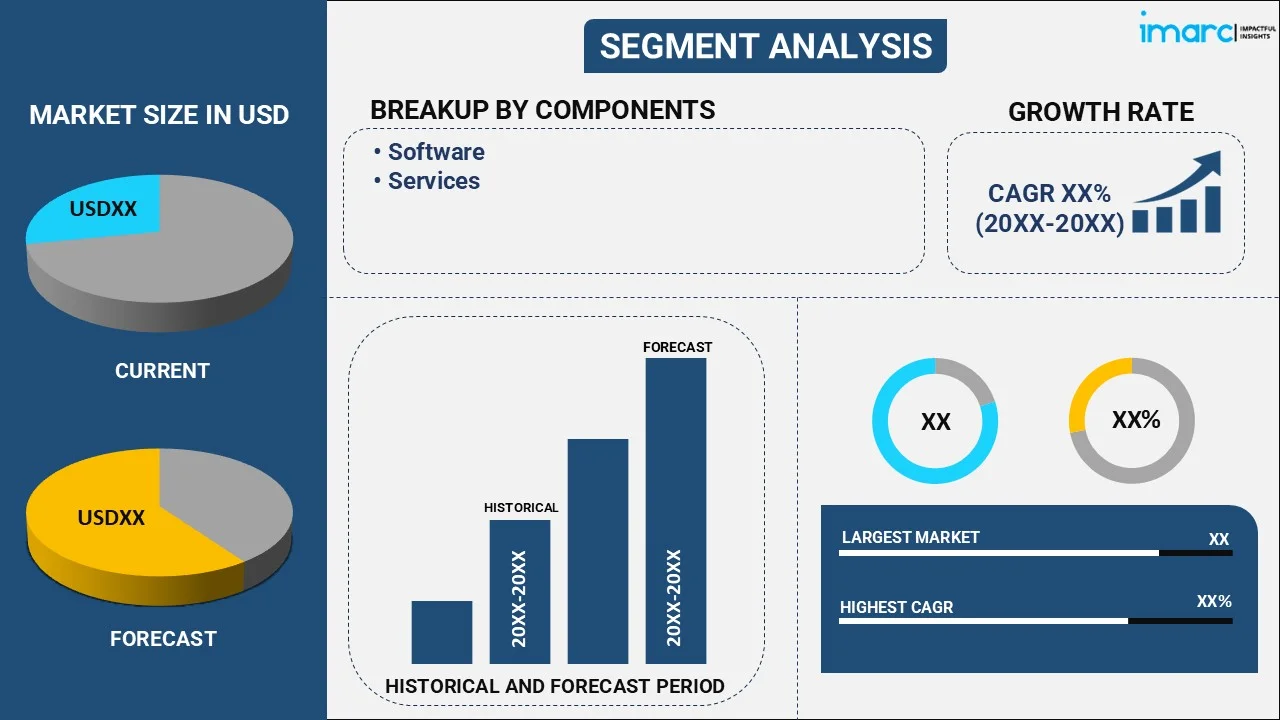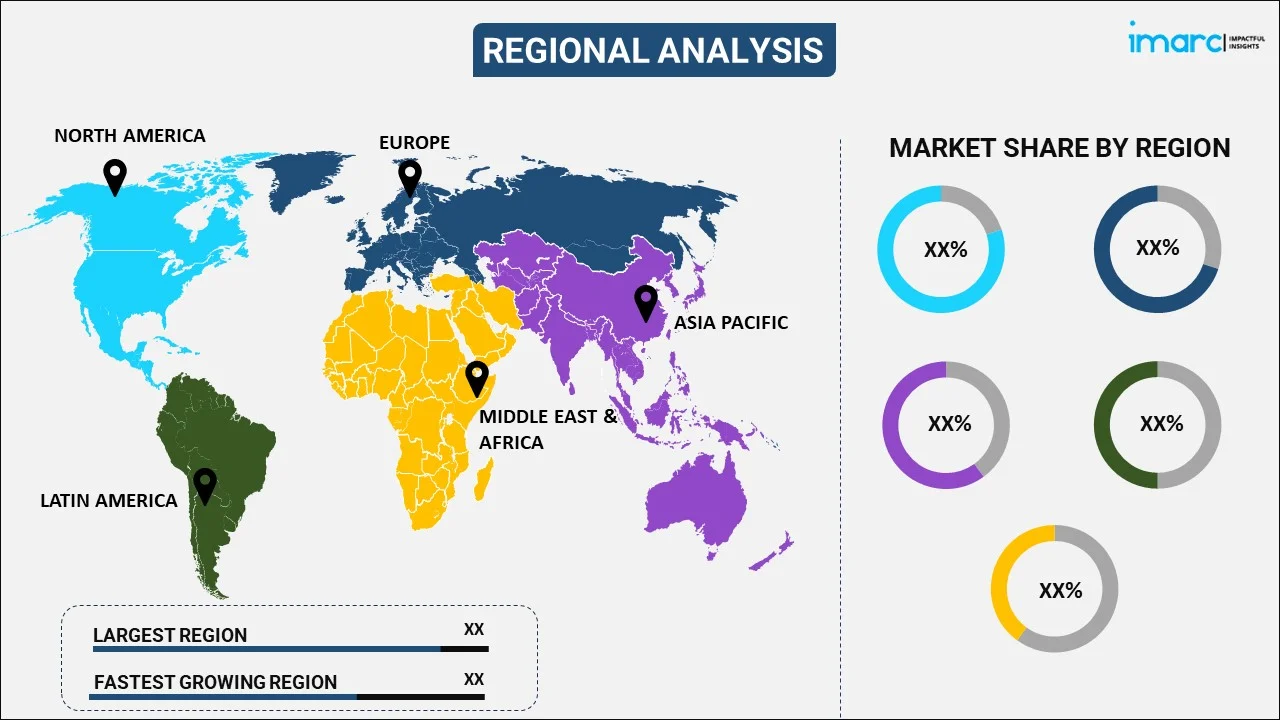
Tax Management Software Market Report by Component (Software, Services), Deployment Mode (Cloud-based, On-premises), Organization Size (Small and Medium-sized Enterprises, Large Enterprises), Industry Vertical (Retail, BFSI, Healthcare, Energy and Utilities, Manufacturing, and Others), and Region 2025-2033
Global Tax Management Software Market:
The global tax management software market size reached USD 18.1 Billion in 2024. Looking forward, IMARC Group expects the market to reach USD 49.9 Billion by 2033, exhibiting a growth rate (CAGR) of 11.92% during 2025-2033. The increasing trend of automation to offer seamless financial transactions, complex tax regulations, and the rising number of cross-border transactions, owing to the growing trade activities, are bolstering the market growth.
|
Report Attribute
|
Key Statistics
|
|---|---|
|
Base Year
|
2024 |
|
Forecast Years
|
2025-2033
|
|
Historical Years
|
2019-2024
|
| Market Size in 2024 | USD 18.1 Billion |
| Market Forecast in 2033 | USD 49.9 Billion |
| Market Growth Rate (2025-2033) | 11.92% |
Global Tax Management Software Market Analysis:
- Major Market Drivers: The growing concerns among individuals and business organizations towards data security and privacy are primarily fueling the tax management software market demand. Moreover, the increasing focus among organizations on improving overall financial efficiency while ensuring compliance with the complex landscape of tax laws is also acting as another significant growth-inducing factor.
- Key Market Trends: The introduction of efficient tax management processes that accurately calculate tax while saving time is one of the emerging trends bolstering the tax management software market outlook. Furthermore, the inflating number of small and medium-sized enterprises will continue to stimulate the tax management software market share in the coming years.
- Geographical Trends: According to the tax management software market analysis, North America accounted for the largest market share. This is due to the wide presence of consulting services, solution providers, and skilled professionals across the region. Moreover, the widespread adoption of digital solutions is expected to fuel the regional market over the forecasted period.
- Competitive Landscape: Some of the leading tax management software market companies include Avalara, Inc., Avantax, Inc., Drake Software LLC, HRB Digital LLC, Intuit Inc, Sailotech Pvt Ltd., SAP SE, SAXTAX Software, Sovos Compliance, LLC, TaxJar (Stripe, Inc.), TaxSlayer LLC, Thomson Reuters Corporation, Vertex, Inc., and Wolters Kluwer N.V., among many others.
- Challenges and Opportunities: One of the primary challenges hampering the tax management software market revenue includes the constantly changing tax laws and regulations across countries. This, in turn, requires regular updation of tax management software to ensure compliance and avoid penalties for users. However, the increasing usage of automation that can address this challenge by interpreting and applying complex tax rules, thereby minimizing the potential for mistakes, is projected to fuel the global market over the forecasted period.

Global Tax Management Software Market Trends:
Complex Tax Regulations and Compliance
The implementation of stringent regulations by government bodies presents a significant challenge for businesses aiming to maintain accurate compliance. This, in turn, is propelling the demand for tax management software. The software addresses this challenge by providing automated features that apply and interpret complex tax rules and reduce the potential for mistakes, which is acting as another significant growth-inducing factor. Additionally, the introduction of indirect tax management software is also bolstering the global market. For example, in November 2021, Thomson Reuters, a tax management software provider, announced the development of the Indirect Tax (IDT) Determination Anywhere platform. This launch provided tax professionals with a tax determination engine at any point of a transaction within any channel. Moreover, in February 2023, Avalara Inc., a tax management software company, introduced Avalara Property Tax for businesses and accountants. In line with this, with the aid of this development, consumers were enabled to leverage the software for improving tax compliance while introducing automation.
Strategic Collaborations
Numerous prominent players are entering into strategic collaborations to expand their market presence. They are launching novel software that can handle diverse tax systems, streamline processes, reduce the risk of double taxation, enhance the accuracy of cross-border tax management, etc., which is one of the tax management software market's recent opportunities. For example, in April 2023, Vestmark, Inc., a wealth management software and service provider, announced the launch of VAST, an outsourced portfolio management service focusing on personalization at scale. It offers several benefits, such as the flexible open architecture of numerous investment options, comprehensive tax management, streamlined implementation, simple-to-use advisor interface, etc. Key players are also entering into collaborations, mergers and acquisitions, partnerships, etc. For instance, in February 2023, BitPay, a crypto payment application provider, entered a partnership with ZenLedger, a crypto tax management software. Moreover, this partnership was aimed at simplifying cryptocurrency tax filing for all Bitpay users.
Increasing Preference for Automation
The growing digitalization in several sectors is contributing to the market growth. Moreover, the shifting preference towards digital tax management solutions, as they aid in automating repetitive tasks, such as calculations, data entry, report generation, etc., with reduced time as compared to manual work, is elevating the tax management software market's recent price. Furthermore, cloud-based tax management platforms allow businesses to access their tax data anytime, thereby enabling real-time decision-making, which is augmenting the global market. For example, the Attilio Group (TAG), a cloud-based back-office solution provider, utilized the SOVOS cloud tax management solution to eliminate inefficient and time-consuming tax reporting processes. In line with this, in May 2023, the Internal Revenue Service (IRS) announced the launch of a pilot program for the year 2024 for a free e-filing system. Moreover, the program is introduced to help taxpayers in filing their taxes directly to the IRS for free.
Global Tax Management Software Market Segmentation:
IMARC Group provides an analysis of the key trends in each segment of the market, along with forecasts at the global, regional, and country levels for 2025-2033. Our report has categorized the market based on component, deployment mode, organization size, and industry vertical.
Breakup by Component:

- Software
- Services
- Training Services
- Consulting and Implementation
- Support Services
Software represents the largest market segment
The report has provided a detailed breakup and analysis of the market based on the component. This includes software and services (training services, consulting and implementation, and support services). According to the report, software represented the largest segment.
The software usually comprises digital platforms and solutions that provide the core tax management functionalities. It generally encompasses a wide range of features, such as reporting, compliance automation, tax calculation, data analytics, integration capabilities, etc. In addition to this, it enables businesses to streamline their tax processes, enhance accuracy, and optimize financial decisions via automated tools and real-time insights. For example, Ryan, a global tax service and software-providing company, partnered with Alteryx Inc., an analytics automation company. This partnership was aimed at improving Ryan’s ability to deliver technology-enabled transformation to improve the business outcomes of customers by automating their tax process by leveraging the newly launched solution.
Breakup by Deployment Mode:
- Cloud-based
- On-premises
On-premises account for the majority of the market share
The report has provided a detailed breakup and analysis of the market based on the deployment mode. This includes cloud-based and on-premises. According to the report, on-premises accounted for the largest market share.
On-premises deployment is the process of installing the software directly onto an organization's servers and infrastructure. According to the tax management software market overview, the growth of this segmentation is driven by the increasing concerns towards data security, compliance with specific regulations, and the inflating need for necessary resources to maintain and manage the software in-house. For example, companies, including Sage Group plc, are involved in providing on-premises digital signature solutions to users, enabling them to ensure and maintain high data security.
Breakup by Organization Size:
- Small and Medium-sized Enterprises
- Large Enterprises
Large enterprises hold the biggest market share
The report has provided a detailed breakup and analysis of the market based on the organization size. This includes small and medium-sized enterprises and large enterprises. According to the report, large enterprises accounted for the largest market share.
Large enterprises are organizations with extensive operations, significant employee numbers, higher revenue levels, etc. These organizations often deal with complex tax scenarios, owing to their scale and international operations. Moreover, this software caters to their intricate tax needs by offering advanced features, such as cross-border transaction management, international tax calculations, and integration with other enterprise systems, thereby driving the market growth in this segmentation.
Breakup by Industry Vertical:
- Retail
- BFSI
- Healthcare
- Energy and Utilities
- Manufacturing
- Others
BFSI dominates the largest market share
The report has provided a detailed breakup and analysis of the market based on the industry vertical. This includes retail, BFSI, healthcare, energy and utilities, manufacturing, and others. According to the report, BFSI accounted for the largest market share.
The BFSI sector deals with intricate regulatory requirements and financial transactions. The software is crucial for these institutions to handle several taxes, such as income tax, capital gains tax, corporate taxes, etc. The software streamlines tax calculations for investment transactions, financial products, insurance premiums, etc.
Breakup by Region:

- North America
- United States
- Canada
- Europe
- Germany
- France
- United Kingdom
- Italy
- Spain
- Others
- Asia Pacific
- China
- Japan
- India
- South Korea
- Australia
- Indonesia
- Others
- Latin America
- Brazil
- Mexico
- Others
- Middle East and Africa
North America exhibits a clear dominance, accounting for the largest tax management software market share
The market research report has also provided a comprehensive analysis of all the major regional markets, which include North America (the United States and Canada); Europe (Germany, France, the United Kingdom, Italy, Spain, and others); Asia Pacific (China, Japan, India, South Korea, Australia, Indonesia, and others); Latin America (Brazil, Mexico, and others); and the Middle East and Africa. According to the report, North America accounted for the largest market share.
The wide presence of prominent players, such as Thomson Reuters, Wolters Kluwer N.V., and Intuit, Inc., in North America is primarily propelling the market growth in the region. Furthermore, the escalating demand for specialized tax software that caters to sector-specific complexities is impelling the growth of the market. Apart from this, the introduction of tax management software by key players across the region is also acting as another significant growth-inducing factor. For example, in February 2023, Avalara, Inc., a tax management software provider, announced the introduction of Avalara Property Tax for businesses and accountants. Consequently, the customers were enabled to leverage the software for enhancing tax compliance while introducing automation. The government bodies in North America are launching favorable policies, thereby positively influencing the regional market.
Competitive Landscape:
Major players are enhancing the technological capabilities of their tax management solutions. This includes integrating advanced features, such as artificial intelligence (AI), machine learning (ML), and data analytics, to provide more accurate tax calculations, real-time insights, and predictive analytics for tax planning. In addition, many companies recognize the importance of offering customizable solutions that can seamlessly integrate with existing systems and workflows of clients. They are working closely with clients to tailor their software to specific business needs and ensure a smooth transition and improved user experience. Furthermore, they are investing in user-friendly interfaces and intuitive designs to ensure that users can navigate and utilize the functionalities of software effectively, reduce the learning curve, and maximize productivity.
The market research report has provided a comprehensive analysis of the competitive landscape. Detailed profiles of all major companies have also been provided. Some of the key players in the market include:
- Avalara, Inc.
- Avantax, Inc.
- Drake Software LLC
- HRB Digital LLC
- Intuit Inc
- Sailotech Pvt Ltd.
- SAP SE
- SAXTAX Software
- Sovos Compliance, LLC
- TaxJar (Stripe, Inc.)
- TaxSlayer LLC
- Thomson Reuters Corporation
- Vertex, Inc.
- Wolters Kluwer N.V.
(Please note that this is only a partial list of the key players, and the complete list is provided in the report.)
Global Tax Management Software Market News:
- January 2024: The Internal Revenue Service (IRS) is introducing a new program this year that aims to help individuals in the United States file their taxes directly to the government for free.
- November 2023: Intuit, a technology platform that makes Credit Karma, TurboTax, QuickBooks, Mailchimp, etc., announced the improvements for its products and services, including Intuit ProConnect Tax, Intuit Tax Advisor, Intuit Lacerte Tax, Intuit ProSeries Tax, etc.
Tax Management Software Market Report Scope:
| Report Features | Details |
|---|---|
| Base Year of the Analysis | 2024 |
| Historical Period | 2019-2024 |
| Forecast Period | 2025-2033 |
| Units | Billion USD |
| Scope of the Report | Exploration of Historical and Forecast Trends, Industry Catalysts and Challenges, Segment-Wise Historical and Predictive Market Assessment:
|
| Components Covered |
|
| Deployment Modes Covered | Cloud-based, On-premises |
| Organization Sizes Covered | Small and Medium-sized Enterprises, Large Enterprises |
| Industry Verticals Covered | Retail, BFSI, Healthcare, Energy and Utilities, Manufacturing, Others |
| Regions Covered | Asia Pacific, Europe, North America, Latin America, Middle East and Africa |
| Countries Covered | United States, Canada, Germany, France, United Kingdom, Italy, Spain, China, Japan, India, South Korea, Australia, Indonesia, Brazil, Mexico |
| Companies Covered | Avalara, Inc., Avantax, Inc., Drake Software LLC, HRB Digital LLC, Intuit Inc, Sailotech Pvt Ltd., SAP SE, SAXTAX Software, Sovos Compliance, LLC, TaxJar (Stripe, Inc.), TaxSlayer LLC, Thomson Reuters Corporation, Vertex, Inc., Wolters Kluwer N.V., etc. |
| Customization Scope | 10% Free Customization |
| Post-Sale Analyst Support | 10-12 Weeks |
| Delivery Format | PDF and Excel through Email (We can also provide the editable version of the report in PPT/Word format on special request) |
Key Benefits for Stakeholders:
- IMARC’s report offers a comprehensive quantitative analysis of various market segments, historical and current market trends, market forecasts, and dynamics of the tax management software market from 2019-2033.
- The research study provides the latest information on the market drivers, challenges, and opportunities in the global tax management software market.
- The study maps the leading, as well as the fastest-growing, regional markets. It further enables stakeholders to identify the key country-level markets within each region.
- Porter's five forces analysis assists stakeholders in assessing the impact of new entrants, competitive rivalry, supplier power, buyer power, and the threat of substitution. It helps stakeholders to analyze the level of competition within the tax management software industry and its attractiveness.
- Competitive landscape allows stakeholders to understand their competitive environment and provides an insight into the current positions of key players in the market.
Key Questions Answered in This Report
- How has the global tax management software market performed so far, and how will it perform in the coming years?
- What are the drivers, restraints, and opportunities in the global tax management software market?
- What is the impact of each driver, restraint, and opportunity on the global tax management software market?
- What are the key regional markets?
- Which countries represent the most attractive tax management software market?
- What is the breakup of the market based on the component?
- Which is the most attractive component in the tax management software market?
- What is the breakup of the market based on the deployment mode?
- Which is the most attractive deployment mode in the tax management software market?
- What is the breakup of the market based on the organization size?
- Which is the most attractive organization size in the tax management software market?
- What is the breakup of the market based on the industry vertical?
- Which is the most attractive industry vertical in the tax management software market?
- What is the competitive structure of the global tax management software market?
- Who are the key players/companies in the global tax management software market?
Need more help?
- Speak to our experienced analysts for insights on the current market scenarios.
- Include additional segments and countries to customize the report as per your requirement.
- Gain an unparalleled competitive advantage in your domain by understanding how to utilize the report and positively impacting your operations and revenue.
- For further assistance, please connect with our analysts.
 Inquire Before Buying
Inquire Before Buying
 Speak to an Analyst
Speak to an Analyst
 Request Brochure
Request Brochure
 Request Customization
Request Customization




.webp)




.webp)












